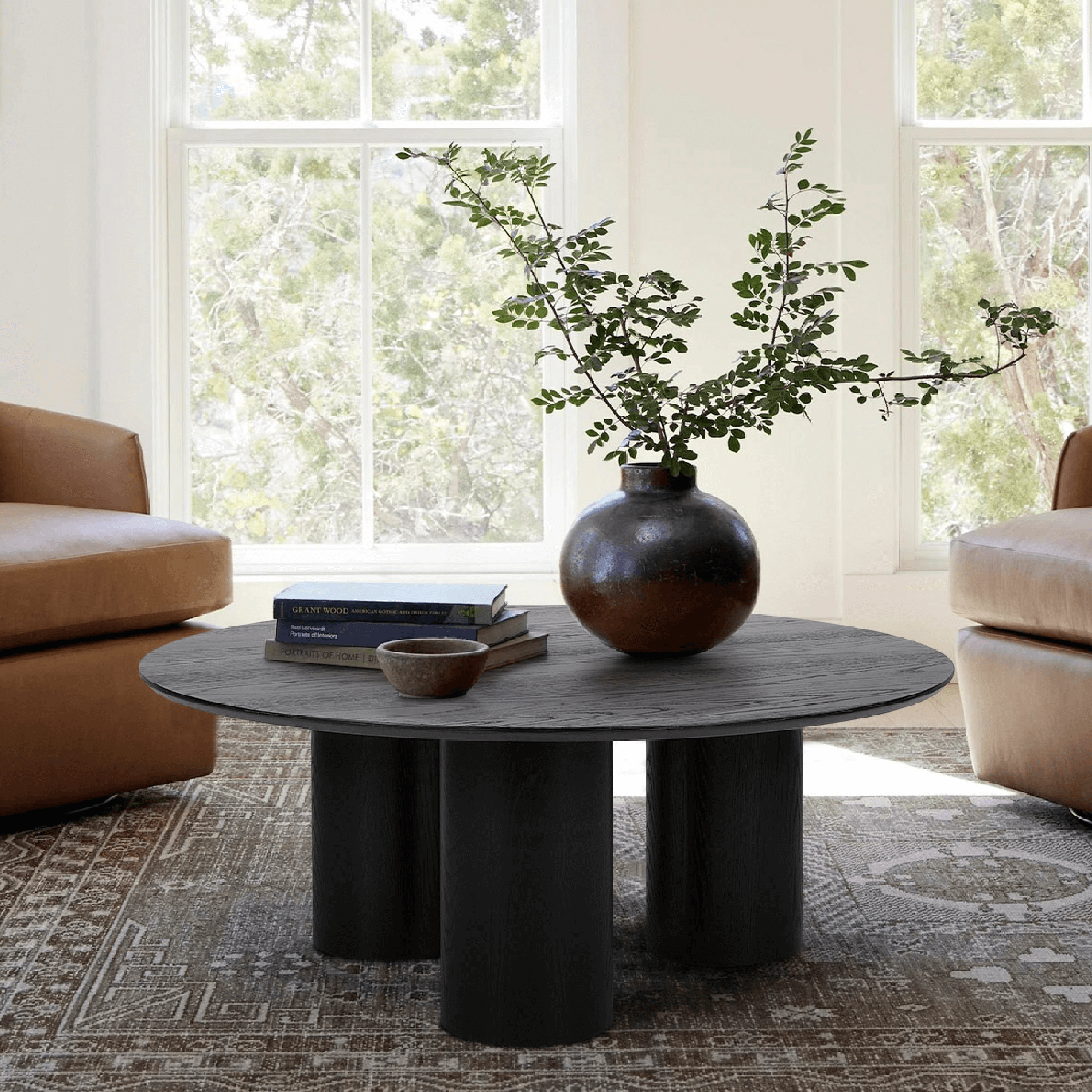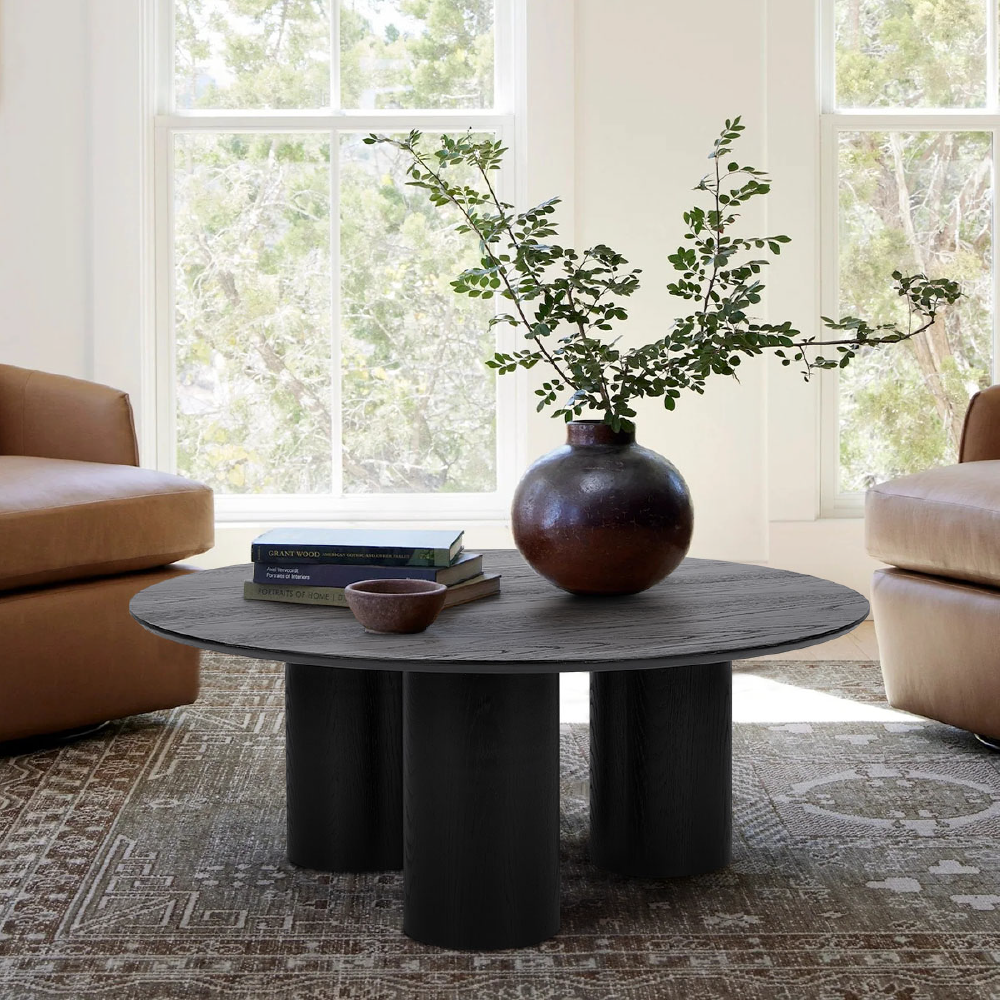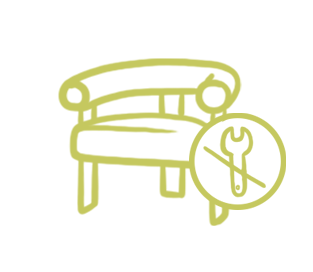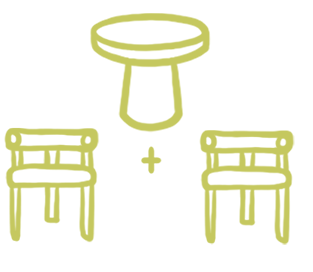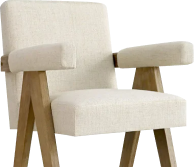Table seating capacity for round and rectangular or square tables is determined by the size of the table and also by the width of the chairs you plan to use. Round round dining tables seat from 4 to 12 people, though the most popular sizes between 35 inches and 60 inches in diameter seat from 4 to 8 people.
Rectangular tables also seat from 4 to 12 people, though the most popular sizes from 42 inches to 96 inches seat from 4 to 10 people.
In general, rectangular tables have greater seating capacity per square foot of surface area, especially compared to large round tables where space in the middle of the table is wasted.
This guide to table seating capacity provides table size and seating capacity lists and charts. It will help you make an informed decision when choosing a table with the right seating capacity for your everyday needs and for entertaining too.
What is the Seating Capacity for Different Round Dining Table Sizes?
Round tables range from 35” to 84” in size, and they seat 4 to 12 people depending on the size.
Here are common round table sizes and the maximum number of dining chairs that can be placed around them.
- 35-42 inches: Seats up to 4
- 44-52 inches: Seats up to 6 people
- 54 inches: Seats up to 8 people
- 60 inches: Seats up to 8 people
- 66 inches: Seats up to 10 people
- 72 inches: Seats up to 10 people
- 78 inches: Seats up to 10 people
- 84 inches: Seats up to 12 people
|
Table Size or Diameter |
Minimum Suggested Seating |
Maximum Seating |
|
35-42 inches |
2 |
4 |
|
44-52 inches |
3 |
5 or 6 |
|
54 inches |
4 |
6 or 8 |
|
60 inches |
6 |
6 or 8 |
|
66 inches |
6 |
8 or 10 |
|
72 inches |
6 |
8 or 10 |
|
78 inches |
8 |
10 |
|
84 inches |
9 |
12 |

The maximum number of chairs varies based on the width of the chairs. For example, a 60-inch table seats a maximum of 6 chairs that are wider than 24 inches but can accommodate 8 narrower chairs. The minimum suggested seating is listed in the chart to remind you not to buy a table that is too big for your needs - one that will feel a little empty like, for example, a 72-inch table with only four chairs around it.
The right dining table size for you is one that fits into your dining space and still allows adequate room around the table for foot traffic. The recommended clearance is 36” on all sides between the table and the wall or other furniture. And 24” is the bare minimum where space is limited.
Secondly, the table should be full or nearly full at most meals, or the table will “feel” too large and empty. For example, if the number of people at most meals is 5, then a 54” table is ideal. A 60” table works too, but a 66” table or larger might begin to feel too big.
What is the Seating Capacity for Different Rectangular Dining Table Sizes?
Rectangular dining tables including square tables seat 4-16 people. Seating capacity is based primarily on length, though width can be a factor if two seats rather than one fit at each end.
Here are common lengths of rectangular tables.
- 42-44 inches: Seats up to 4
- 44-48 inches: Seats up to 6
- 54-66 inches: Seats up to 4 with one on each end or up to 6 with two on each end
- 66-84 inches: Seats up to 6 with one on each end or up to 8 with two on each end
- 84-102 inches: Seats up to 8 with one on each end and up to 10 with two on each end
- 102-144 inches: Seats 8 or 10 with one on each end or up to 12 with two on each end
|
Table Length |
Minimum Suggested Seating |
Maximum Seating |
|
42-44 inches |
2 |
4 |
|
44-48 inches |
4 |
6 |
|
54-66 inches |
4 |
6 |
|
66-84 inches |
6 |
8 |
|
84-102 inches |
8 |
10 |
|
102-144 inches |
8 |
12 |

Here is a common rule of thumb: When considering tables 4 feet long or longer, in general, it will seat one person per foot of table. A 4-foot table seats 4 comfortably. A 6-foot table seats 6 comfortably, etc.
How Much Can You Increase Seating Capacity with Leaves?
You will find a selection of both round and rectangular tables that are expandable with leaves or other types of extensions.
Expandable tables, aka extendable tables, offer flexibility in seating based on the number of people that will be sitting at the table.
- Removable or insertable leaves are separate panels. The table is split apart, usually on rails, and the leaves are inserted or removed and stored apart from the table.
- Drop leaves are hinged panels that fold down when not in use. The advantage is that they don’t need to be stored apart from the table. The disadvantage is that seating on the side with the folded-down panel isn’t possible.
- Self-storing leaves are panels with a hinge that allows them to be folded up and stored inside the table. Butterfly leaves are a type of self-storing table leaf.
- Telescoping or sliding panels are pulled out to lengthen the table. Some of these designs have legs on the extended panels that fold down for support. These are called gate-leg tables.
This table lists tables with the various types of leaves and their design plus whether the leaves are stored with the table or separate (removable).
|
Type |
Design |
Storage |
|
Removable leaves |
Table sides split apart to remove/insert |
Separate |
|
Drop leaves |
Hinged leaves fold down at table sides |
In the table |
|
Self-storing leaves |
Hinges leaves fold and are hidden in the table |
On the table |
|
Telescoping leaves |
Hidden leaves extend outward, some with legs |
In the table |
What Factors Affect Seating Capacity?
The number of chairs that are placed at the table is determined by these factors.
Round vs rectangular tables: Generally speaking, rectangular tables maximize seats per square foot of table surface area.
Space per chair: The total space for each chair should be the chairs’ width plus 2-8 inches for spacing. If chairs are narrow, more space between chairs is needed to accommodate adults of an average size. Also, for casual dining, less space is needed per chair than for formal dining. This is because on formal dining occasions, there are often more pieces of silverware, more plates, etc., and more space is required on the table. This requires spacing the chairs further apart. Finally, children generally need less space between chairs, due to their smaller stature, than adults.
Table perimeter: Given that you need 20-28 inches of table perimeter per chair, you can determine how many chairs a table can accommodate by doing the math. For example, the circumference or perimeter of a 60-inch (diameter) round table is 188.5 inches. This is found using the formula C=πd where C is circumference and d is diameter.
Example: With allowing 2-8 inches of space between chairs, which is common spacing, here are the number of chairs that fit a 60-inch round table:
- 18-inch chairs: 6-8 chairs
- 20-inch chairs: 6-8 chairs
- 22-inch chairs: 6-8 chairs
- 24-inch chairs: 5-7 chairs
- 26-inch chairs: 5-7 chairs
Width of the chairs: Obviously, the wider the chairs, the fewer chairs you can place around a table. Chairs without armrests, which are called side chairs, are 18-21 inches wide. Armchairs, or chairs with armrests or backs that wrap around, are available in widths from 20-26 inches. Upholstered dining chairs are typically wider than average – up to 26 inches wide whether or not they have armrests.
How Much Room is Needed Per Dining Chair?
For side chairs, those without arms, here is the space per chair you’ll need.
- 22-26 inches: Recommended
- 19-22 inches: Tight seating
- More than 26 inches: Spacious seating
For dining chairs with armrests, aka armchairs, here is the space per chair needed.
- 24-28 inches: Recommended
- 20-24 inches: tight seating
- More than 28 inches: Spacious seating
What is Dining Bench Seating Capacity?
When comparing bench vs chairs seating, bench seating is more compact than chair seating.
Instead of 20 to 28 inches or more per chair/per person for chair seating, it’s common to need only 16 to 22 inches per person on a dining bench. Of course, the size of the people and their willingness to sit close to each other other are factors to consider.
Table Capacity and Room Size
When considering table capacity, you need to factor in the size of the room.
You need a minimum of 24 inches (2 feet) between the edges of the table and the wall or other furniture for people to be able to get around their room to chairs in the corner or at the far end of the table. The recommended distance between the table and the wall or furniture is 36 inches (3 feet).
So, table capacity and room size are definitely linked. Regardless of the number of people you’d like to seat, the room has to be large enough to accommodate the dining table for that many chairs.
How Do I Choose the Right Seating Capacity for Our Needs
These tips for choosing a dining table size, one with the right seating capacity for your needs, will help you select a table you’ll be happy with in the years ahead.
First, and obviously, consider the typical number of people at the table for most meals. A table that is mostly full produces a more homey, connected feel than one that has a lot of empty seats.
Secondly, how much do you entertain or have extra people for dinner – extended family, friends, friends of your children, etc.? If having guests is infrequent, then size the table for your household and use a second table when necessary for guests.
If you entertain a lot, consider a bigger table or one with one or more leaves, an extendable table, so that you can customize its size to fit each occasion.
Lastly, do you use your table for activities other than eating? If you fold laundry, use the table for work or homeowner, craft, do large puzzles or other activities that take up space, then a larger dining table or extendable table might be a better fit.
Round Table Seating Pros and Cons
Round is a great shape for conversation, since everyone sitting at a round table is facing the middle and can easily see all the others. Nobody has to turn their head sharply to see another diner. There is no
head of the table, so that everyone feels equal. Round tables maximize the space in a spacious room, especially if the room is square or nearly square where they fit the space very well. They aren’t as good a fit for longer, narrower rooms.
Round tables with one or more leaves are available which turn the table into an oval shape. This has the advantage of increasing seating without increasing the table width in all directions.
Additionally, tables with seating for more than 8 have a wide diameter, and that makes conversation harder because people on opposite sides are further apart. Finally, a large round table is difficult to move through doorways.
Rectangular Table Seating Pros and Cons
Rectangular and square tables maximize your seating because the lines of chairs are straight and not curved. These tables fit the dimensions of many rooms, so the layout is harmonious.
Many square and rectangular tables come with leaves or extension panels to make them extendable for more chairs when necessary. This flexibility is ideal for smaller households that frequently host guests for dinner. Their shape makes it easier to move them through doorways when necessary.
The longer the table is, the harder it is to converse with others distant from you, so they are less inclusive. And you have to turn sharply to your sides to see and talk with those on the same side of the table as you.







